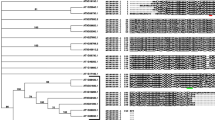Abstract
Sequence comparison with the mevalonate diphosphate decarboxylase (MVD) amino acid sequence of Saccharomyces cerevisiae identified an EST clone corresponding to a cDNA that may encode Arabidopsis thaliana MVD (AtMVD1). This enzyme catalyses the synthesis of isopentenyl diphosphate, the building block of sterol and isoprenoid biosynthesis, and uses mevalonate diphosphate as a substrate. Sequencing of the full-length cDNA was performed. The predicted amino acid sequence presents about 55% identity with the yeast, human and rat MVDs. The sequence of the genomic region of A. thaliana MVD was also obtained and Southern blot analysis on genomic DNA showed that A. thaliana could have at least one homologous MVD gene. In order to allow heterologous expression in S. cerevisiae, the MVD open reading frame (ORF) was then cloned under the control of the yeast PMA1 strong promoter. When expressed in yeast, the A. thaliana cDNA complemented both the thermosensitive MN19-34 strain deficient in MVD, and the lethal phenotype of an ERG19 deleted strain. However, the wild-type sterol content was not fully restored suggesting that the A. thaliana MVD activity may not be optimal in yeast. A two-hybrid assay was also performed to evaluate homodimer formation of the A. thaliana MVD and heterodimer formation between the plant and yeast heterologous enzymes.
Similar content being viewed by others
References
Bach TJ: Some new aspects of isoprenoids biosynthesis in plants: a review. Lipids 30: 191–202 (1995).
Bergès T, Guyonnet D, Karst F: Characterisation of a Leu-to-Pro mutation in a conserved sequence of mevalonate diphosphate decarboxylase in yeast. J Bact 179: 4664–4670 (1997).
Cardemil E, Jabalquinto AM: The mechanism of action of mevalonate-5-pyrophosphate decarboxylase. Trends Biochem Sci 8: 7 (1983).
Chambon C, Ladevèze V, Blanchard L, Javelot C, Vladescu B, Karst F: Sterol pathway in yeast. Identification and properties of mutant strains defective in mevalonate diphosphate decarboxylase and farnesyl diphosphate synthetase. Lipids 26: 633–636 (1991).
Chappell J: Biochemistry and molecular biology of the isoprenoid biosynthetic pathway in plants. Annu Rev Plant Physiol Plant Mol Biol 46: 521–547 (1995).
Cunillera N, Arro M, Delourme D, Karst F, Boronat A, Ferrer A: Arabidopsis thaliana contains two differentially expressed farnesyl-diphosphate synthase genes. J Biol Chem 271: 7774–7780 (1996).
Gietz RD, St Jean A, Woods RA, Schiestl RH: Improved method for high efficiency transformation of intact yeast cells. Nucl Acids Res 20: 1425 (1992).
Goldstein JL, Brown MS: Regulation of mevalonate pathway. Nature 343: 425–430 (1990).
Goodwin TW, Mercer EI: The control of lipid metabolism. In: Grant JK (ed), pp. 37–40. Academic Press, London (1963).
Guthrie C, Fink GR: Guide to yeast genetics and molecular biology. Meth Enzymol 194: 310–311 (1991).
Jabalquinto AM, Alvear M, Cardemil E: Physiological aspects and mechanism of action of mevalonate 5-diphosphate decarboxylase. Comp Biochem Physiol 90B: 671–677 (1988).
Kreuz K, Kleinig H: Synthesis of prenyllipids in cells of spinach leaf, compartmentation of enzymes for formation of isopentenyl diphosphate. Eur J Biochem 141: 531–535 (1984).
Kribii R, Arro M, Del Arco A, Gonzales V, Balcells L, Delourme D, Ferrer A, Karst F, Boronat A: Cloning and characterisation of the Arabidopsis thaliana SQS1 gene encoding squalene synthase. Involvement of the C-terminal region of the enzyme in the channeling of squalene through the sterol pathway. Eur J Biochem 249: 61–69 (1997).
Lichtenthaler HK, Schwender J, Disch A, Rohmer M: Biosynthesis of isoprenoids in higher plant chloroplasts proceeds via a mevalonate-independent pathway. FEBS Lett 400: 271–274 (1997).
Marcireau C, Guyonnet D, Karst F: Construction and growth properties of a yeast strain defective in sterol 14 reductase. Curr Genet 22: 267–272 (1992).
Newman T, De Bruijn FJ, Green P, Keegstra K, Kende H, McIntosh L, Ohlrogge J, Raikhel N, Somerville S, Thomashaw M, Retzel E, Somerville C: Genes galore: a summary of methods for accessing results from large-scale partial sequencing of anonymous Arabidopsis DNA clones. Plant Physiol 106: 1241–1255 (1994).
Rodriguez RJ, Taylor FR, Parks LW: A requirement for ergosterol to permit growth of yeast sterol auxotrophs on cholestanol. Biochem Biophys Res Comm 106: 435–441 (1982).
Rogers SO, Bendich AJ: Extraction of milligram amounts of fresh, herbarium and mummified plant tissues. Plant Mol Biol 5: 69–76 (1985).
Rohmer M, Knani M, Simonin P, Sutter B, Sahm H: Isoprenoid biosynthesis in bacteria: a novel pathway for the early steps leading to isopentenyl diphosphate. Biochem J 295: 517–524 (1993).
Rose MD, Winston F, Hieter P: Methods in Yeast Genetics: A Laboratory Course Manual. Cold Spring Harbor Laboratory Press, Cold Spring Harbor, NY (1990).
Sanger F, Nicklen S, Coulson AR: DNA sequencing with chain-terminating inhibitors. Proc Natl Acad Sci USA 74: 5463–5467 (1977).
Schwender J, Seemann M, Lichtenthaler HK, Rohmer M: Biosynthesis of isoprenoids (carotenoids, sterols, prenyl sidechains of chlorophylls and plastoquinone) via a novel pyruvate/ glyceraldehyde 3-phosphate non-mevalonate pathway in the green alga Scenedesmus obliquus. Biochem J 316: 73–80 (1996).
Servouse M, Karst F: Regulation of ergosterol biosynthesis in Saccharomyces cerevisiae. Biochem J 240: 541–547 (1986).
Sikorski RS, Hieter P: A system of shuttle vectors and yeast host strains designed for efficient manipulation of DNA in Saccharomyces cerevisiae. Genetics 122: 19–27 (1989).
Toth MJ, Huwyler L: Molecular cloning and expression of the cDNAs encoding human and yeast mevalonate pyrophosphate decarboxylase. J Biol Chem 271: 7895–7898 (1996).
Toth MJ, Huwyler L, Park J: Purification of rat liver mevalonate pyrophosphate decarboxylase. Prep Biochem Biotechnol 26: 47–51 (1996).
Villalba JM, Palmgreen MG, Berberian GE, Fergusson C, Serrano R: Functional expression of plant plasma membrane HC-ATPase in yeast endoplasmic reticulum. J Biol Chem 267: 12341–12349 (1991).
Vojtek AB, Hollenberg SM, Cooper JA: Mammalian Ras interact directly with the serine/threonine kinase Raf. Cell 74: 205–214 (1993).
Author information
Authors and Affiliations
Rights and permissions
About this article
Cite this article
Cordier, H., Karst, F. & Bergès, T. Heterologous expression in Saccharomyces cerevisiae of an Arabidopsis thaliana cDNA encoding mevalonate diphosphate decarboxylase. Plant Mol Biol 39, 953–967 (1999). https://doi.org/10.1023/A:1006181720100
Issue Date:
DOI: https://doi.org/10.1023/A:1006181720100




